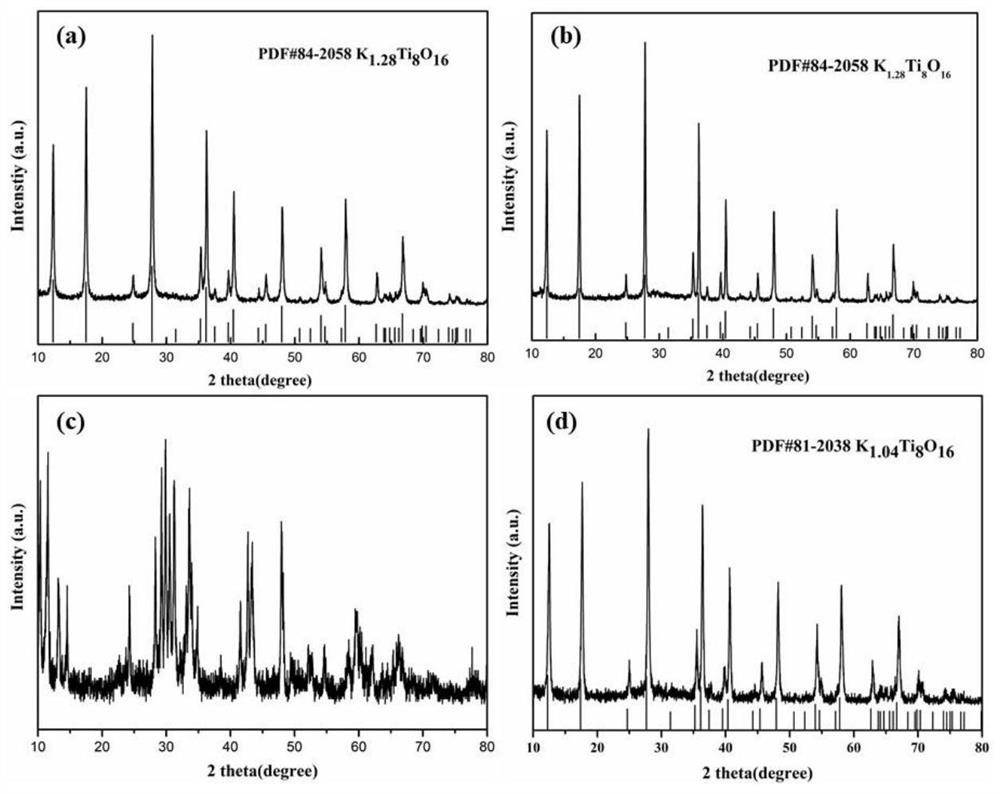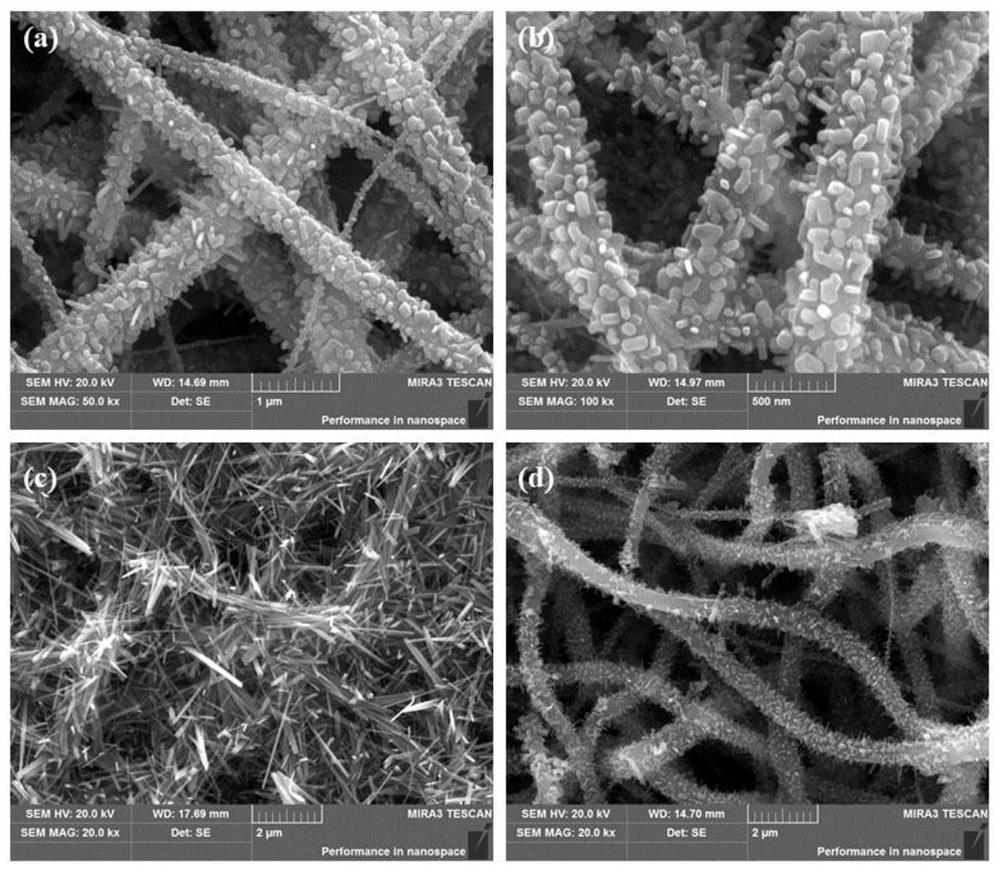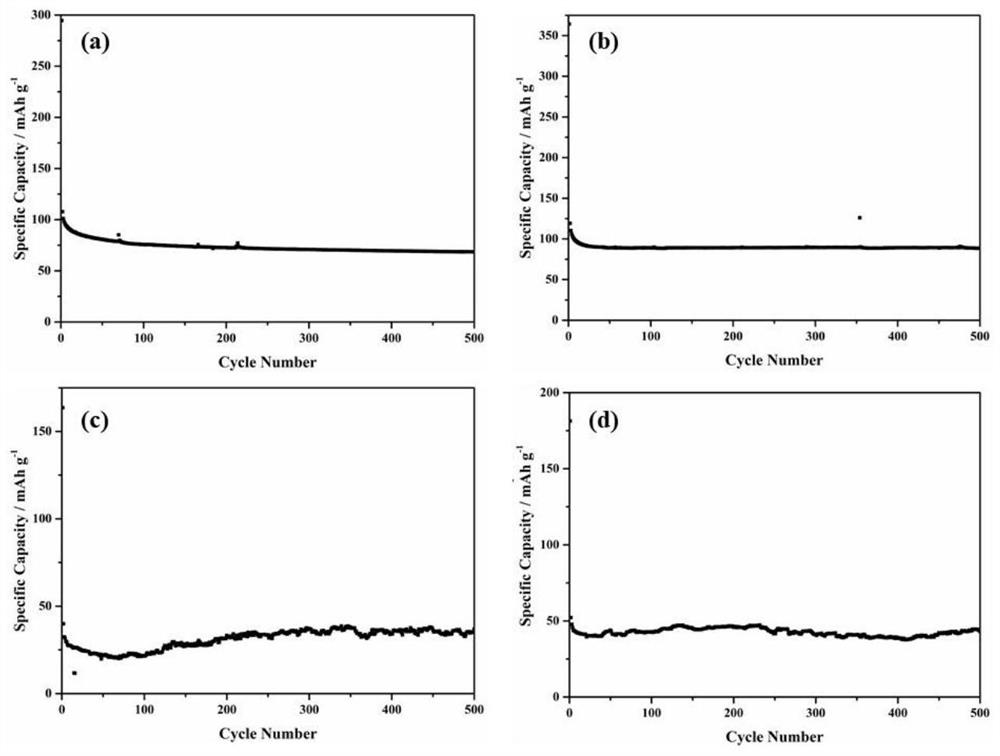K1.28Ti8O16, composite carbon nanofiber, preparation method of composite carbon nanofiber and application of composite carbon nanofiber in sodium-ion battery
A k1.28ti8o16, nanofiber technology, applied in the chemical characteristics of fibers, circuits, negative electrodes, etc., can solve the problems of lack of negative active materials, long-term cycle stability of electrochemical performance, etc., to achieve excellent long-term cycle stability, The effect of excellent crystal phase stability
- Summary
- Abstract
- Description
- Claims
- Application Information
AI Technical Summary
Problems solved by technology
Method used
Image
Examples
Embodiment 1
[0071] 1) Preparation of precursor solution: Mix 8g ethanol, 2.4g acetic acid, and 2.85g tetrabutyl titanate at 20-25°C to obtain a mixed solvent, and add an appropriate amount of CH 3 COOK (K / Ti molar ratio is 1:3.0), magnetic stirring at 500rpm at room temperature for 30min to make CH 3 COOK was completely dissolved; then 1 g of polyvinylpyrrolidone was added, and magnetically stirred at the same rotational speed for 12 hours to obtain an electrospinning precursor solution.
[0072] 2) Electrospinning: extract 15ml of precursor solution with a medical syringe, and use a No. 20 flat-mouth stainless steel needle to spin on an electrospinning device. The nanofibers obtained by spinning are received by aluminum foil; the distance between the needle and the receiving plate is 22cm , the spinning voltage is 20KV, the ambient temperature is 25°C, the humidity is 30%, and the feeding speed is 0.8ml / h.
[0073] 3) The nanofibers obtained by spinning were pre-carbonized in a muffle f...
Embodiment 2
[0079] 1) Preparation of precursor solution: Mix 8g ethanol, 2.4g acetic acid, and 2.85g tetrabutyl titanate at 20-25°C to obtain a mixed solvent, and add an appropriate amount of CH 3 COOK (K / Ti molar ratio is 1:2.5), magnetic stirring at 500rpm for 30min to make CH 3 COOK was completely dissolved; then 1 g of polyvinylpyrrolidone was added, and magnetically stirred at the same rotational speed for 12 hours to obtain an electrospinning precursor solution.
[0080] 2) Electrospinning: extract 15ml of precursor solution with a medical syringe, and use a No. 20 flat-mouth stainless steel needle to spin on an electrospinning device. The nanofibers obtained by spinning are received by aluminum foil; the distance between the needle and the receiving plate is 22cm , the spinning voltage is 20KV, the ambient temperature is 25°C, the humidity is 30%, and the feeding speed is 0.8ml / h.
[0081] 3) The nanofibers obtained by spinning were pre-carbonized in a muffle furnace (air atmosphe...
Embodiment 3
[0087] 1) Preparation of precursor solution: Mix 8g ethanol, 2.4g acetic acid, and 2.85g tetrabutyl titanate at 20-25°C to obtain a mixed solvent, and add an appropriate amount of CH 3 COOK (K / Ti molar ratio is 1:3.5), magnetic stirring at 500rpm for 30min to make CH 3 COOK was completely dissolved; then 1 g of polyvinylpyrrolidone was added, and magnetically stirred at the same rotational speed for 12 hours to obtain an electrospinning precursor solution.
[0088] 2) Electrospinning: extract 15ml of precursor solution with a medical syringe, and use a No. 20 flat-mouth stainless steel needle to spin on an electrospinning device. The nanofibers obtained by spinning are received by aluminum foil; the distance between the needle and the receiving plate is 22cm , the spinning voltage is 20KV, the ambient temperature is 25°C, the humidity is 30%, and the feeding speed is 0.8ml / h.
[0089] 3) The nanofibers obtained by spinning were pre-carbonized in a muffle furnace (air atmosphe...
PUM
| Property | Measurement | Unit |
|---|---|---|
| Diameter | aaaaa | aaaaa |
| Diameter | aaaaa | aaaaa |
| Diameter | aaaaa | aaaaa |
Abstract
Description
Claims
Application Information
 Login to View More
Login to View More - Generate Ideas
- Intellectual Property
- Life Sciences
- Materials
- Tech Scout
- Unparalleled Data Quality
- Higher Quality Content
- 60% Fewer Hallucinations
Browse by: Latest US Patents, China's latest patents, Technical Efficacy Thesaurus, Application Domain, Technology Topic, Popular Technical Reports.
© 2025 PatSnap. All rights reserved.Legal|Privacy policy|Modern Slavery Act Transparency Statement|Sitemap|About US| Contact US: help@patsnap.com



